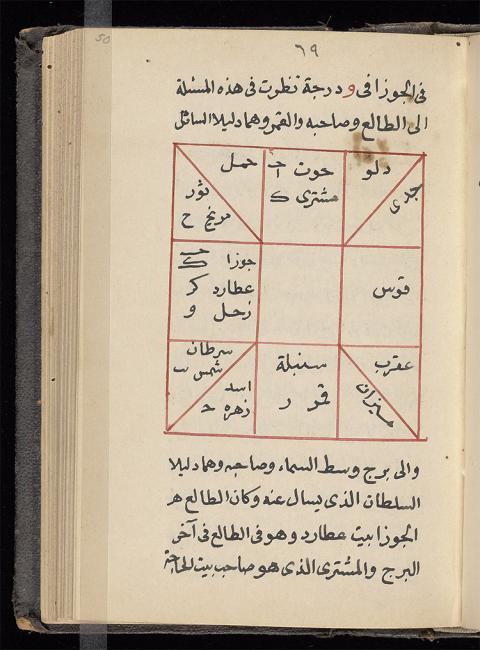Overview
Sahl ibn Bishr (fl. 205 AH/AD 821–235 AH/AD 850) was an astrologer and mathematician at the service of the governor of the Khurāsān Ṭāhir ibn al-Ḥusayn al-Aʽwar (205/821–207/822) and who later served al-Ḥasan ibn Sahl (died 236/ 850–1) secretary and governor of caliph al-Ma’mūn (198/813–218/833). This implies that he was in Baghdad during the great programme of astronomical research patronised by al-Ma’mūn and when the interest in astrology, which had begun under al-Manṣūr (136/754–158/775), reached its apex.

Sahl ibn Bishr
Little information about Sahl survives; we only know that he was a Jew who converted to Islam. All his extant works are astrological and, according to a list provided by Ibn al-Nadīm in 377/977-78, they dealt with all branches of astrology: nativity horoscopes (Kitāb al-mawālīd al-kabīr and al-ṣaghīr), anniversaries of nativities (Kitāb taḥāwīl sinī al-mawālīd), elections (Kitāb al-ikhtiyārāt), interrogations (Kitāb al-masā’il al-kabīr), world astrology (Kitāb taḥāwīl sinī al-ʽālam), astrological meteorology (Kitāb al-amṭār wa l-riyāḥ) and so on. These materials were probably summarised in his Kitāb al-madkhal al-kabīr and al-ṣaghīr. We know his works reached al-Andalus around 338/950 because they are quoted in the Ghāyat al-ḥakīm (Picatrix), and they were translated into Latin by an anonymous translator of the twelfth century, as well as into Byzantine Greek. A Latin corpus of his writings, in which his name appears as Zael/Zahel/Zahel Benbriz, is extant in about fifty-five manuscripts and in seven printed editions dated between AD 1484 and 1551.
Sahl’s Treatise on Interrogations (masā’il)
The work preserved in the British Library manuscript Or. 12802 bears no title, although another copy at Yale (Arabic MSS 523) is entitled Kitāb fī ʽilm al-falak wa l-burūj wa l-aḥkām al falakiyya ʽalā l-tamām wa l-kamāl (a book which deals exhaustively with astronomy, the zodiacal signs and astrological predictions). This kind of astrological book would have been designed for the upper classes of society, and differed from the more popular kind of texts used by astrologers who worked in the city markets.

It has two clear parts: the first is an introduction dealing with the zodiacal signs (the twelve houses of the horoscope) and sixteen ḥālāt, which analyse the conditions of a planet in relation to the others in the same horoscope. These horoscopes are often related to the second part, on interrogations. An interrogation (mas’âla), is an astrological technique consisting of casting a horoscope ‘of the moment’, in which a question is addressed to the astrologer who will try to answer it. The moment is important because a horoscope depends on two variables: time (the moment for which the horoscope is cast) and place (the local latitude). Interrogations formed the main topic of the rest of the book and they are classified according to the twelve houses of the horoscope, each one of them having a specialised field of interest. There is also an appendix dealing with topics unrelated to the houses. These kind of texts – as well as treatises on ‘elections’ (ikhtiyārāt), which try to choose a propitious moment for undertaking a particular activity – have an obvious interest for social historians because they give information about the kind of problems that concerned people of that time.

Sahl’s Legacy
The work of Sahl ibn Bishr is a clear example of the interest shown in astrology during part of the Abbasid period (second/eighth–fourth/tenth centuries), probably due to Persian influence. His treatise on interrogations only mentions by name the authority of another Jewish astrologer, Māshā’allāh (died c. 200/815–6), but it has been proven that it uses the Pentateuch of Dorotheus of Sidon, translated from Pahlevi by ʽUmar ibn Farrukhān al-Ṭabarī (died 200/ 815–6). The patronage of the Abbasid rulers reveals that they were keenly interested in knowing the future, and Sahl is representative of the astrologers who worked in the circles of power at that time. Sahl’s works were later translated into Latin and underwent a remarkable diffusion in Western Europe.




